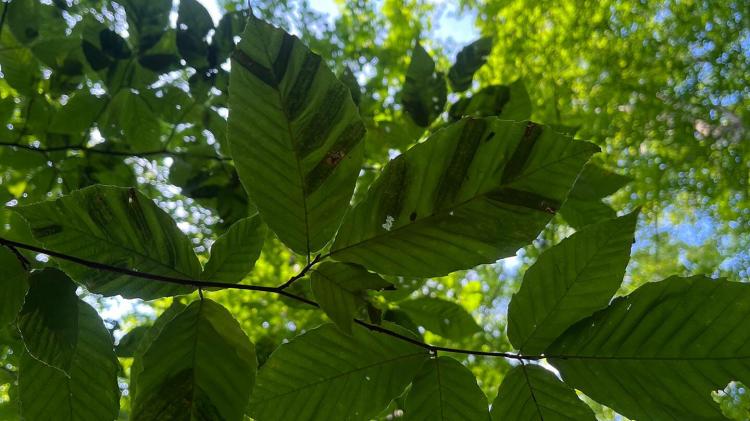
A new forest disease identified in Maine just three years ago is now present in all 16 counties in the state, raising concerns among ecologists and wildlife managers as it targets one of the Northeast’s most ecologically valuable trees.
Beech leaf disease is caused by a microscopic worm, or nematode, and leads to curling and dark banding in leaves, eventually resulting to a dieback from the branch tips inward, according to recent research from University of Vermont.
Other threats to beech trees, including bark disease, primarily affect mature trees. However, the leaf disease can attack saplings and seedlings, which endangers the species from long-term spread and growth.
First identified in Ohio in 2012, the disease has spread steadily across the eastern United States and has been confirmed in counties across Vermont and New Hampshire and is now present throughout Maine.
State foresters on Tuesday announced that they’ve recorded the first tree deaths from the disease in Maine, this week in the midcoast region, Maine Public reported.

It’s causing great concerns about beech tree mast, or the production of beechnuts, a source of food for many of the state’s native species including black bears, deer and turkeys, said Anthony D’Amato, a forest ecologist at the University of Vermont.
“In many northern hardwood forests, beech serves as a key mast species,” he said. “And its decline may have implications for wildlife species that depend on it, particularly in areas where alternative mast species (e.g., oaks) are absent or rare.”
Unlike pests and blight, beech leaf disease kills slowly with a lag between infection and visible decline, which complicates detection. Though how the disease spreads isn’t known, researchers believe the nematodes may be carried by wind, water and animals.
Aaron Bergdahl, a forest pathologist with the Maine Forest Service, said research suggests nematodes migrate to the following year’s buds during late summer and can be spread by rain and wind, birds and human activity.
“A gust of wind can potentially transport them great distances,” he said.
An infection typically appears in saplings before showing symptoms in mature trees, D’Amato said. Bergdahl noted that research across nine monitoring spots shows saplings in older infestation areas are in extreme decline if not dead altogether, while more mature trees are showing signs of worsening dieback.
Only a few experimental treatments in controlled environments have shown any promise in preventing the disease, according to UVM research. There are no known methods for containing the disease or eradicating it in natural settings. Researchers are tracking the spread of nematodes to hopefully identify resistant trees and are evaluating broader strategies.
Beech trees affected by the disease do continue to produce nuts, though production is reduced due to physiological stress, D’Amato said. Bergdahl said this mast production could be a “last-ditch effort to reproduce as infected trees decline.”
Bergdahl noted that beech trees in Maine have not yet indicated any resistance to the disease and very few have shown resistance in other long-infested states. “There are very few management strategies at this point, so it’s really a matter of continued monitoring and research,” he said. “Forest managers are focusing on identifying resistant individuals that may be retained in the forest to allow for future regeneration and persistence of the species.”
Impacted forests are undergoing ecological transition, Bergdahl said, as dieback opens up forest canopy, allowing more sunlight to hit the forest floor.
“Different species will likely thrive, causing changes in habitat,” he said. “One particular concern would be if invasive plant species proliferate and prevent the healthy regeneration of native tree species.”
Foresters are being advised to retain healthy beeches in areas undergoing harvest, in case those trees offer genetic resistance, D’Amato said. Some landowners are prioritizing beech for firewood, which encourages the regeneration of other species to support future forests, Bergdahl added.
“There’s real potential to learn from trees that are showing tolerance,” D’Amato said. “Those individuals might be the key to future forest resilience.”

We invite you to add your comments. We encourage a thoughtful exchange of ideas and information on this website. By joining the conversation, you are agreeing to our commenting policy and terms of use. More information is found on our FAQs. You can modify your screen name here.
Comments are managed by our staff during regular business hours Monday through Friday as well as limited hours on Saturday and Sunday. Comments held for moderation outside of those hours may take longer to approve.
Join the Conversation
Please sign into your CentralMaine.com account to participate in conversations below. If you do not have an account, you can register or subscribe. Questions? Please see our FAQs.